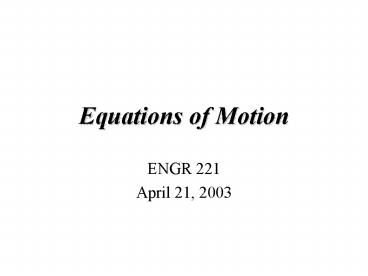Equations of Motion - PowerPoint PPT Presentation
1 / 29
Title:
Equations of Motion
Description:
... in order that the arms of the gondolas will assume an angle of q=60o, ... the arms to which the gondolas are attached and treat each gondola as a particle. ... – PowerPoint PPT presentation
Number of Views:1212
Avg rating:3.0/5.0
Title: Equations of Motion
1
Equations of Motion
- ENGR 221
- April 21, 2003
2
Lecture Goals
- Rectilinear Equations of Motion
- Curvilinear Equations of Motion
- Energy
3
Example Problem Equation of Motion
Compute the distance s which the block travels up
the incline from its point of release, where its
initial velocity is 9 m/s to a point where its
velocity is 6 m/s. The coefficient of friction
between the incline and the block is 0.30.
4
Example Problem Equation of Motion
Draw the free-body diagram of the block.
5
Example Problem Equation of Motion
Rewrite the equation for vertical
acceleration The frictional force is
6
Example Problem Equation of Motion
Compute the horizontal acceleration
7
Example Problem Equation of Motion
The acceleration is defined as
8
Example Problem Equation of Motion
Plug in the acceleration equation
9
Class Problem Curvilinear Motion
A particle P having a mass of 2 kg is given an
initial velocity at A in the smooth guide, which
is curved in the vertical plane. If the particle
has a horizontal velocity at the top B of the
guide, where its radius of curvature is 0.5 m,
calculate the force exerted on the particle by
the guide at this point.
10
Class Problem Curvilinear Motion
In design of a space station to operate outside
the earths gravitational field, it is desired to
give the structure a rotational speed N which
will simulate the effect of the earths gravity
for members of the crew. If the centers of the
crews quarters are to be located 8 m from the
axis of rotation, calculate the necessary
rotation speed N of the space station in rpms.
11
Example Problem Rectilinear Motion
The conical dish rotates about it vertical axis
at the constant speed of 60 rev/min and caries
two spheres with it. Calculate the force N
between each of the 4-kg spheres and the vertical
surface of the dish.
12
Example Problem Curvilinear Motion
Draw the free body diagram of the ball.
13
Example Problem Curvilinear Motion
Solve for N. Plug into the normal equation
14
Example Problem Curvilinear Motion
The acceleration of the ball is The tangential
velocity is
15
Example Problem Curvilinear Motion
The acceleration of the ball is
16
Example Problem Curvilinear Motion
Compute the force
17
Class Problem Curvilinear Motion
Calculate the necessary rotation speed N for the
aerial ride in the amusement park in order that
the arms of the gondolas will assume an angle of
q60o, with the vertical. Neglect the mass of
the arms to which the gondolas are attached and
treat each gondola as a particle.
18
Example Problem Curvilinear motion
A block B of mass m may slide freely on a
frictionless arm OA, which rotates in a
horizontal plane at a constant rate ,
Knowing that B is released at a distance r0 from
O and express as a function of r (a) the
components vr of the velocity of B along AO, (b)
the magnitude of the horizontal force F exerted
on B by the arm OA.
19
Example Problem Curvilinear motion
Draw the free body diagram of the block B.
20
Example Problem Curvilinear motion
Determine the velocity of the r component
Substitute into the equation for r double dot
21
Example Problem Curvilinear motion
Integrate
22
Example Problem Curvilinear motion
Insert the
to find the force.
23
Example Problem Curvilinear motion
The slotted arm revolves with a constant angular
velocity w about a vertical axis through the
center of O of the fixed cam. The cam is cut so
that the radius to the path of the center of the
pin A varies according to r r0 bsin(Nwt)
where N is the number of lobes - six in this
case. If w 12 rad/s, r0 100 mm, b 10 mm and
the compression in the spring varies from 11.5 N
to 19.1 N from valley to crest, calculate the
force R between the cam and the 100-g pin A as it
passes over the top of the lobe in the position
shown.
24
Example Problem Curvilinear motion
Draw the free-body of the mass Find the
derivatives of r
25
Example Problem Curvilinear motion
The peak occurs when sin(Nwt) 1 and the
acceleration in the q direction is zero
26
Example Problem Curvilinear motion
Compute the accelerations
27
Example Problem Curvilinear motion
Find the force R
28
Class Problem Curvilinear motion
A 2 kg particle moves in a horizontal plane its
polar coordinates given by r 50t3 - 75t 100 and
q 2sin(pt / 2) where r is in millimeters, q is
in radians, and t is in seconds. Compute the
resultant horizontal force on particle at the
instant t 2 sec.
29
Homework (Due 4/28/03)
Problems
15-61, 15-66, 15-73, 15-74, 15-104































